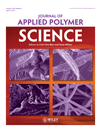Effects of atomic oxygen and ultraviolet in low earth orbit on low surface energy polymer film
Abstract
Effects of atomic oxygen (AO) and ultraviolet (UV) on a polymer film with surface energy of 8.0 mJ m−2 derived from poly(1H,1H-perfluorooctyl methylacrylate) were investigated by contact angle measurements, X-ray photoelectron spectroscopy, and atomic force microscope. The film was exposed to AO with a flux of 6.73 × 1015 atoms cm−2 s−1 and UV with intensity of 15.8 mW cm−2 at wavelength of 200–450 nm, respectively. It is found that AO and UV irradiation resulted in the reduction of film thickness, change of wettability, and increase of surface energy, and AO exhibited more serious effects than UV on the fluorinated polymer film. Reduced rate of thickness of the film was almost proportional to the AO exposure time. After exposed to AO and UV irradiation, the surface energy of the film increased to 17.3 mJ m−2 and 11.0 mJ m−2, respectively. © 2010 Wiley Periodicals, Inc. J Appl Polym Sci, 2011




